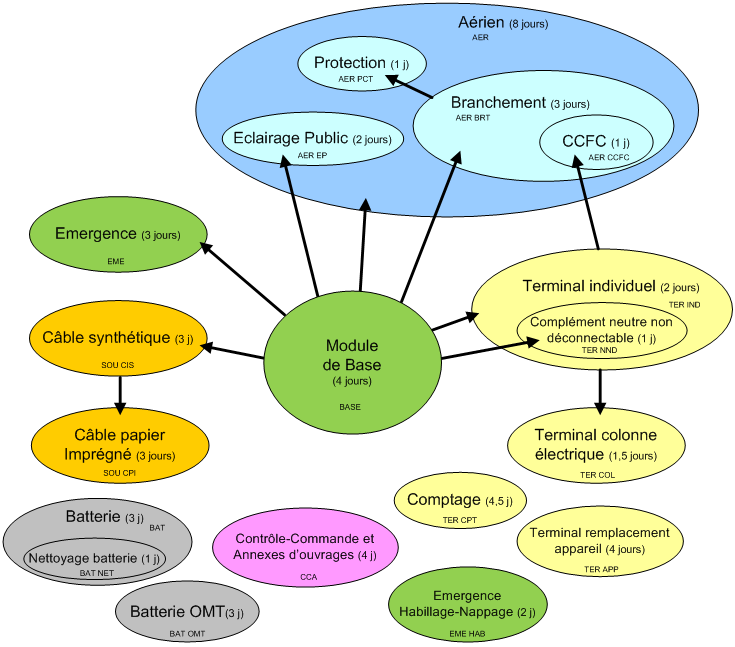There are currently about 30,000 operators working in LV (voltage below 1,000 V), 1,000 people in MV (1 kV to 50 kV) and 300 people in HV (voltages above 50 kV).
In accordance with the decree dated 16 February 1982 and the interministerial decision on 1 July 1983, the Committee approves training programmes and authorises Live Working training centres.
Training centres are authorised for renewable periods.
Training is delivered by a group of organisations with sites spread across the country. These organisations are linked either directly to the network managers (ERDF, RTE and local distribution companies), or to other professional organisations or institutions, such as SERCE, AFPA, etc. (list of establishments or organisations authorised to give training for Live Working on LV electrical power distribution grids).
For high voltage (MV and HV), ERDF and RTE are the only ones to have authorised training bodies.
As part of their authorisation, the LW activity of the centres concerns training courses dedicated to electrical power distribution or transport networks. They must be quality certified to ISO 9001 for training. They are themselves responsible for ensuring the quality of training given by all trainers involved and have training facilities representative of actual installations. They report annually to the Committee on their activities.
The focus of the Committee is part of its commitment to maximise the safety of operators and achieve greater quality of execution of the work. Training courses take an overall approach as opposed to training based on operating procedures, emphasising the ability of operators to analyse risks. Based on a full understanding of current best practice (WC, TDS, etc.), this training must include a theoretical part and a practical part.
The LV training course
Initial training is certified by issuing an aptitude assessment for Live Working.
Numerous organisations and training centres are authorised for the various LV LW training courses.
There are 18 different modules. These modules are either independent or dependent (e.g. the base module before the Emergence module).

There are 3 types of training courses:
A BASE module constitutes a first approach to Live Working. It is used to develop the skills needed to prepare and carry out executing limited activities on 'Emergence' grids.
A positive aptitude assessment following this module creates the possibility for the trainee to take one or more specific training modules.
Specific modules for the different types of grids and network equipment technologies. These modules are taken in addition to the base module.
Independent modules, access to which is not conditional on having previously taken the base module because they include all or part of the base module.
The modules are:
|
Code |
Base |
Spécifique |
Indépendant |
Titre |
|---|---|---|---|---|
| AER PCT | X | Ouvrage aérien limité à la pose de protections | ||
|
BAS |
X |
|
|
Module de base |
|
EME |
|
X |
|
Ouvrage en émergence |
|
SOU CIS |
|
X |
|
Ouvrage souterrain limité au câble à isolation synthétique. |
|
SOU CPI |
|
X |
|
Ouvrage souterrain en câble à isolation au papier imprégné. |
|
AER |
|
X |
|
Ouvrage aérien. |
|
AER BRT |
|
X |
|
Ouvrage aérien limité au branchement aérien et aéro-souterrain. |
|
AER EP |
|
X |
|
Ouvrage aérien limité à l’éclairage public. |
|
AER CCFC |
|
X |
|
Ouvrage aérien limité à la pose de coupe circuit fusible cylindrique. |
|
TER IND |
|
X |
|
Ouvrage terminal individuel. |
|
TER COL |
|
X |
|
Colonne électrique. |
|
TER NND |
|
X |
|
Ouvrage terminal avec neutre non déconnectable. |
|
TER CPT |
|
|
X |
Comptage direct ou sur réducteur sur ouvrage terminal. |
|
TER APP |
|
|
X |
Remplacement d’appareil sur ouvrage terminal. |
|
CCA |
|
|
X |
Contrôle-commande et annexes d’ouvrages. |
|
BAT |
|
|
X |
Batteries. |
|
BAT NET |
|
|
X |
Batteries limité au nettoyage. |
| BAT OMT |
X |
Batteries limitées aux OMT | ||
| EME HAB |
X |
Emergences limitées à l'habillage-nappage |
